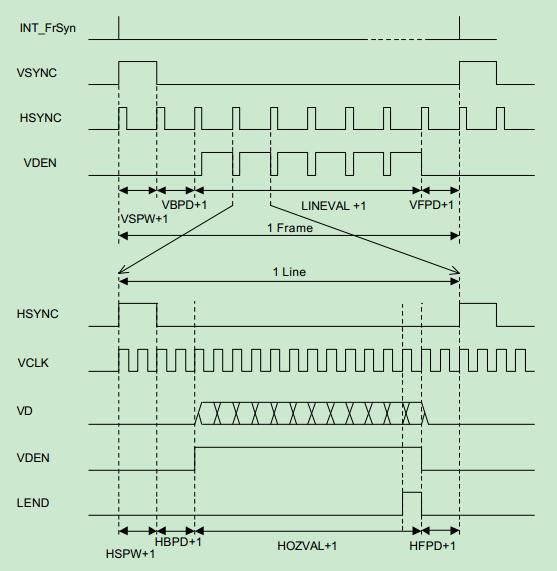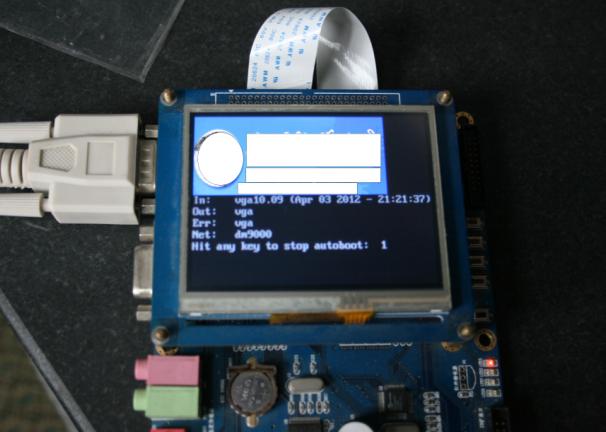FL2440的U-boot-2010.09移植(七)LCD的支持
一、LCD时序配置
fl2440开发板的LCD是3.5寸屏型号是WXCAT35-TG3#001,这是一款320x240分辨率的TFT LCD屏,先来了解一下TFT LCD的时序如下:
图1 TFT LCD时序
(1)VSYNC信号来一个脉冲时,表示一帧的开始
(2) VSPW表示VSYNC信号的脉冲宽度为(VSPW+1)个HSYNC信号周期,即(VSPW+1)行,这(VSPW+1)行的数据无效。
(3)VSYNC信号脉冲之后,还要经过(VBPD+1)个(HSYNC)信号周期,有效的行数据才出现。所以,在VSYNC信号有效之后,总共还要经过(VSPW+1+VBPD+1)个无效行,
(4)随后连续发出(LINEVAL+1)行的有效数据
(5)最后是(VFPD+1)个无效行,完整的一帧结束,紧接着就是下一帧的数据了(即下一个VSYNC信号)。
(6)HSYNC信号有效时,表示一行数据的开始
(7) HSPW表示HSYNC信号的脉冲宽度为(HSPW+1)个VCLK信号周期,即(HSPW+1)个像素,这(HSPW+1)个像素的数据无效。
(8)HSYNC信号脉冲之后,还要经过(HBPD+1)个VCLK信号周期,有效的像素数据才会出现。所以,在HSYNC信号有效之后,总共还要经过(HSPW + 1 + HBPD + 1)个无效的像素,第一个有效像素才出现。
(9)随后即连续发出(HOZVAL+1)个像素的有效数据。
(10)最后是(HFPD+1)个无效的像素,完整的一行结束,紧接着就是下一行的数据了(即下一个HSYNC信号)。
TFT LCD的正常工作主要需要配置S3C2440的寄存器LCDCON1~LCDCON5。
二、u-boot支持LCD的配置工作
首先要添加一个文件,driver/video/s3c2410_fb.c,其内容为:- /*
- * (C) Copyright 2006 by OpenMoko, Inc.
- * Author: Harald Welte <[email protected]>
- *
- * This program is free software; you can redistribute it and/or
- * modify it under the terms of the GNU General Public License as
- * published by the Free Software Foundation; either version 2 of
- * the License, or (at your option) any later version.
- *
- * This program is distributed in the hope that it will be useful,
- * but WITHOUT ANY WARRANTY; without even the implied warranty of
- * MERCHANTABILITY or FITNESS FOR A PARTICULAR PURPOSE. See the
- * GNU General Public License for more details.
- *
- * You should have received a copy of the GNU General Public License
- * along with this program; if not, write to the Free Software
- * Foundation, Inc., 59 Temple Place, Suite 330, Boston,
- * MA 02111-1307 USA
- */
- #include <common.h>
- #if defined(CONFIG_VIDEO_S3C2410)||defined(CONFIG_VIDEO_S3C2440)
- #include <video_fb.h>
- #include <asm/arch/s3c2410.h>
- #include "videomodes.h"
- /*
- * Export Graphic Device
- */
- static GraphicDevice smi;
- #define VIDEO_MEM_SIZE 0x200000 /* 240x320x16bit = 0x25800 bytes */
- extern void board_video_init( GraphicDevice *pGD);
- /*
- * Add by yanghao
- */
- /*******************************************************************************
- *
- * Init video chip with common Linux graphic modes (lilo)
- */
- void *video_hw_init (void)
- {
- struct s3c24x0_lcd * const lcd = s3c24x0_get_base_lcd();
- GraphicDevice *pGD = (GraphicDevice *)&smi;
- int videomode;
- unsigned long t1, hsynch, vsynch;
- char *penv;
- int tmp, i, bits_per_pixel;
- struct ctfb_res_modes *res_mode;
- struct ctfb_res_modes var_mode;
- // unsigned char videoout;
- /* Search for video chip */
- printf("Video: ");
- tmp = 0;
- videomode = CONFIG_SYS_DEFAULT_VIDEO_MODE;
- /* get video mode via environment */
- if ((penv = getenv ("videomode")) != NULL) {
- /* deceide if it is a string */
- if (penv[0] <= '9') {
- videomode = (int) simple_strtoul (penv, NULL, 16);
- tmp = 1;
- }
- } else {
- tmp = 1;
- }
- if (tmp) {
- /* parameter are vesa modes */
- /* search params */
- for (i = 0; i < VESA_MODES_COUNT; i++) {
- if (vesa_modes[i].vesanr == videomode)
- break;
- }
- if (i == VESA_MODES_COUNT) {
- printf ("no VESA Mode found, switching to mode 0x%x ", CONFIG_SYS_DEFAULT_VIDEO_MODE);
- i = 0;
- }
- res_mode =
- (struct ctfb_res_modes *) &res_mode_init[vesa_modes[i].
- resindex];
- bits_per_pixel = vesa_modes[i].bits_per_pixel;
- } else {
- res_mode = (struct ctfb_res_modes *) &var_mode;
- bits_per_pixel = video_get_params (res_mode, penv);
- }
- /* calculate hsynch and vsynch freq (info only) */
- t1 = (res_mode->left_margin + res_mode->xres +
- res_mode->right_margin + res_mode->hsync_len) / 8;
- t1 *= 8;
- t1 *= res_mode->pixclock;
- t1 /= 1000;
- hsynch = 1000000000L / t1;
- t1 *=
- (res_mode->upper_margin + res_mode->yres +
- res_mode->lower_margin + res_mode->vsync_len);
- t1 /= 1000;
- vsynch = 1000000000L / t1;
- /* fill in Graphic device struct */
- sprintf (pGD->modeIdent, "%dx%dx%d %ldkHz %ldHz", res_mode->xres,
- res_mode->yres, bits_per_pixel, (hsynch / 1000),
- (vsynch / 1000));
- printf ("%s\n", pGD->modeIdent);
- pGD->winSizeX = res_mode->xres;
- pGD->winSizeY = res_mode->yres;
- pGD->plnSizeX = res_mode->xres;
- pGD->plnSizeY = res_mode->yres;
- switch (bits_per_pixel) {
- case 8:
- pGD->gdfBytesPP = 1;
- pGD->gdfIndex = GDF__8BIT_INDEX;
- break;
- case 15:
- pGD->gdfBytesPP = 2;
- pGD->gdfIndex = GDF_15BIT_555RGB;
- break;
- case 16:
- pGD->gdfBytesPP = 2;
- pGD->gdfIndex = GDF_16BIT_565RGB;
- break;
- case 24:
- pGD->gdfBytesPP = 3;
- pGD->gdfIndex = GDF_24BIT_888RGB;
- break;
- }
- /* statically configure settings */
- pGD->winSizeX = pGD->plnSizeX = 320;
- pGD->winSizeY = pGD->plnSizeY = 240;
- pGD->gdfBytesPP = 2;
- pGD->gdfIndex = GDF_16BIT_565RGB;
- pGD->frameAdrs = LCD_VIDEO_ADDR;
- pGD->memSize = VIDEO_MEM_SIZE;
- board_video_init(pGD);
- lcd->LCDSADDR1 = pGD->frameAdrs >> 1;
- /* This marks the end of the frame buffer. */
- lcd->LCDSADDR2 = (lcd->LCDSADDR1&0x1fffff) + (pGD->winSizeX+0) * pGD->winSizeY;
- lcd->LCDSADDR3 = (pGD->winSizeX & 0x7ff);
- /* Clear video memory */
- memset((void *)pGD->frameAdrs, 0, pGD->memSize);
- /* Enable Display */
- lcd->LCDCON1 |= 0x01; /* ENVID = 1 */
- return ((void*)&smi);
- }
- #endif /* CONFIG_VIDEO_S3C2410 */
修改driver/video/videomodes.h文件第25行左右为:
- #ifndef CONFIG_SYS_DEFAULT_VIDEO_MODE
- //#define CONFIG_SYS_DEFAULT_VIDEO_MODE 0x301
- #define CONFIG_SYS_DEFAULT_VIDEO_MODE 0x211
- #endif
紧接着修改driver/video/videomodes.h第81行左右为:
- #define RES_MODE_1280x1024 5
- #define RES_MODE_240x320 6
- #define RES_MODES_COUNT 7
- #define VESA_MODES_COUNT 20
在driver/video/videomodes..c文件struct ctfb_vesa_modes vesa_modes定义中添加(第78行左右)本开发板LCD的相关配置:
- {0x211, RES_MODE_240x320, 16},
在driver/video/videomodes..c文件struct ctfb_res_modes res_mode_init定义中添加(第100行左右)本开发板LCD的相关配置:
- {320, 240, 158025, 58, 15, 3, 5, 8, 15, 0, FB_VMODE_NONINTERLACED},
紧接着修改driver/video/Makefile文件,在41行后添加:
- COBJS-$(CONFIG_VIDEO_S3C2440) += videomodes.o
- COBJS-$(CONFIG_VIDEO_S3C2440) += s3c2410_fb.o
最后,修改文件board/fl2440/fl2440.c,在文件最后添加:
- /*
- * Add by yanghao
- */
- #if defined(CONFIG_VIDEO_S3C2440)
- #define MVAL (13)
- #define MVAL_USED (0)
- #define INVVDEN (1)
- #define BSWP (0)
- #define HWSWP (1)
- //TFT 240320
- #define LCD_XSIZE_TFT_240320 (320)
- #define LCD_YSIZE_TFT_240320 (240)
- //TFT 240320
- #define HOZVAL_TFT_240320 (LCD_XSIZE_TFT_240320-1)
- #define LINEVAL_TFT_240320 (LCD_YSIZE_TFT_240320-1)
- //Timing parameter for WXCAT35-TG#001
- #define VBPD_240320 (3)
- #define VFPD_240320 (5)
- #define VSPW_240320 (15)
- #define HBPD_240320 (58)
- #define HFPD_240320 (15)
- #define HSPW_240320_WXCAT35 (8)//adjust the horizontal displacement of the screen
- #define CLKVAL_TFT_240320 (7)
- //FCLK = 405MHZ, HCLK = 101.25MHZ, VCLK=4602272HZ
- void board_video_init(GraphicDevice *pGD)
- {
- struct s3c24x0_lcd * const lcd = s3c24x0_get_base_lcd();
- /*Configuration for fl2440*/
- lcd->LCDCON1 = (CLKVAL_TFT_240320 <<8)|(MVAL_USED <<7)|(3<<5)|(12<<1)|0;
- lcd->LCDCON2 = (VBPD_240320<<24)|(LINEVAL_TFT_240320<<14)|(VFPD_240320<<6)|(VSPW_240320);
- lcd->LCDCON3 = (HBPD_240320<<19)|(HOZVAL_TFT_240320<<8)|(HFPD_240320);
- lcd->LCDCON4 = (MVAL<<8)|(HSPW_240320_WXCAT35);
- lcd->LCDCON5 = (1<<11)|(1<<9)|(1<<8)|(1<<3)|(BSWP<<1)|(HWSWP);
- lcd->LPCSEL = 0x00000000;
- }
- #endif /*CONFIG_VIDEO_S3C2440*/
最后还需要在开发板配置文件中添加LCD屏支持的宏定义,修改文件include/configs/fl2440.h文件,在文件中添加:
- #include <video_fb.h> //头文件定义处添加
- /*****************add by yanghao support LCD文件末尾处添加********************/
- /*LCD support*/
- #define CONFIG_VIDEO_S3C2440 1
- #define CONFIG_VIDEO_LOGO 1
- #define CONFIG_VIDEO_BMP_LOGO 1
- #define VIDEO_FB_16BPP_WORD_SWAP 1
- #define CONFIG_CMD_BMP 1
- //#define CONFIG_LCD 1
- #define CONFIG_VIDEO 1
- #define CONFIG_CFB_CONSOLE 1
- #define CFG_CONSOLE_INFO_QUIET //support display of console information at boot
- #define LCD_VIDEO_ADDR 0x33b00000
- /*for PC-keyboard*/
- #define VIDEO_KBD_INIT_FCT 0
- /*for PC-keyboard*/
- #define VIDEO_TSTC_FCT serial_tstc
- #define VIDEO_GETC_FCT serial_getc
- #define CONFIG_SERIAL_MULTI 1
- /*LCD support*/
重新上电后,uboot的输出就都显示在LCD上了,我们的输入还是选择的串口输入,输入信息也都显示在LCD屏之上效果图如下:

